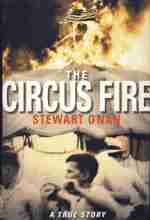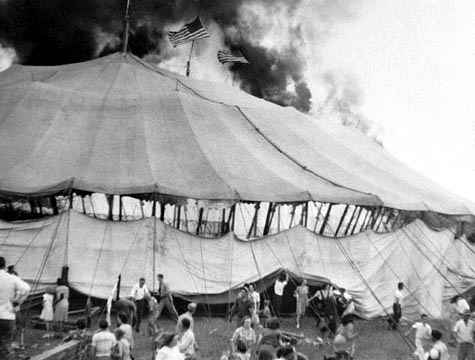 |
|
Did You Know, Merle Evans and the Ringling Brothers and Barnum &Bailey Circus band continued to play during the fire until a quarter pole fell through the bandstand forcing them to quit. |
From Wikipedia, the free encyclopedia
The Hartford circus fire, which occurred on July 6, 1944, in Hartford, Connecticut, was one of the worst fire disasters in the history of the United States. The fire occurred during an afternoon performance of the Ringling Brothers and Barnum &Bailey Circus that was attended by approximately 7,000 people. An estimated 167-169 people died and over 700 were injured.
Contents
In mid-20th century America, a typical circus traveled from town to town by train, performing under a huge canvas tent commonly called a "big top". The Ringling Brothers and Barnum &Bailey Circus was no exception: what made it stand out was that it was the largest circus in the country. Its big top could seat 9,000 spectators around its three rings;the tent's canvas had been coated with 1,800 pounds (820 kg) of paraffin wax dissolved in 6,000 US gallons of gasoline (some sources say kerosene, a common waterproofing method of the time.
The circus had been experiencing shortages of personnel and equipment as a result of the United States' involvement in World War II. Delays and malfunctions in the ordinarily smooth order of the circus had become commonplace;on August 4, 1942, a fire had broken out in the menagerie, killing a number of animals. When the circus arrived in Hartford, Connecticut, on July 5, 1944, the trains were so late that one of the two shows scheduled for that day had been canceled.
The next day was a Thursday;the crowd at the afternoon performance was dominated by women and children. The size of the audience that day has never been established with certainty, but the best estimate is about 7,000.
The fire began as a small flame after the lions performed, on the southwest sidewall of the tent, while the Great Wallendas were performing. Circus band leader Merle Evans is said to be the first to spot the flames, and immediately directed the band to play "The Stars and Stripes Forever", the tune that traditionally signaled distress to all circus personnel. Ringmaster Fred Bradna urged the audience not to panic and to leave in an orderly fashion, but the power failed and he could not be heard. Bradna and the ushers unsuccessfully tried to maintain some order as the panicked crowd tried to flee the big top.
Sources and investigators differ on how many people were killed and injured. Various people and organizations say it was 167, 168, or 169 persons (the 185 figure is usually based on official tallies that included a collection of body parts that were listed as a "victim") with official treated injury estimates running over 700 people. The number of actual injuries is believed to be higher than those figures, since many people were seen that day heading home in shock without seeking treatment in the city. The only animals in the big top at the time were the big cats trained by May Kovar and Joseph Walsh that had just finished performing when the fire started. The big cats were herded through the chutes leading from the performing cages to several cage wagons, and were unharmed except for a few minor burns.
The cause of the fire remains unproven. Investigators at the time believed it was caused by a carelessly flicked cigarette but others suspected an arsonist. Several years later, while being investigated on other arson charges, Robert Dale Segee (1929–1997), who was an adolescent roustabout at the time, confessed to starting the blaze. He was never tried for the crime and later recanted his confession.
Because of the paraffin wax waterproofing of the tent, the flames spread rapidly. Many people were badly burned by the melting paraffin, which rained down from the roof. The fiery tent collapsed in about eight minutes according to eyewitness survivors, trapping hundreds of spectators beneath it.
It is commonly believed that the number of fatalities is higher than the estimates given, due to poorly kept residency records in rural towns, and the fact that some smaller remains were never identified or claimed. It is also believed that the intense heat from the fire combined with the accelerants, the paraffin and gasoline, could have incinerated people completely, as in cremation, leaving no substantial physical evidence behind. Additionally, free tickets had been handed out that day to many people in and around the city, some of whom appeared to eyewitnesses and circus employees to be drifters who would never have been reported missing.
While many people burned to death, many others died as a result of the ensuing chaos. Though most spectators were able to escape the fire, many people were caught up in the hysteria. Witnesses said some simply ran around in circles trying to find their loved ones, rather than trying to escape the burning tent. Some escaped, but ran back inside to look for family members. Others stayed in their seats until it was too late, assuming that the fire would be put out promptly.
Because at least two of the exits were blocked by the chutes used to bring the show's big cats in and out of the tent, people trying to escape could not bypass them. Some died from injuries sustained after leaping from the tops of the bleachers in hopes they could escape under the sides of the tent, though that method of escape ended up killing more than it saved. Others died after being trampled by other spectators, with some asphyxiating underneath the piles of people who fell over each other.
Most of the dead were found in piles, some three bodies deep, at the most congested exits. A small number of people were found alive at the bottoms of these piles, protected by the bodies on top of them when the burning big top ultimately fell down. Because of a picture that appeared in several newspapers of sad tramp clown Emmett Kelly holding a water bucket, the event became known as "the day the clowns cried."
The first investigation
On July 7, charges of involuntary manslaughter were filed against five officials and employees of Ringling Bros. Within days of these charges being filed, the circus reached an agreement with Hartford officials to accept full financial responsibility and pay whatever amount the city requested in damages. This resulted in the circus paying out almost $5,000,000 to the 600 victims and families who had filed claims against them by 1954. All circus profits from the time of the fire until then had been set aside to pay off these claims.
Although the circus accepted full responsibility for the financial damages, they did not accept responsibility for the disaster itself. The five men charged James A. Haley, George W. Smith, Leonard Aylesworth, Edward Versteeg and David W. Blanchfield, were brought to trial in late 1944;four were convicted. Although they were given prison terms, the four men found guilty were allowed to continue with the circus to their next stop, in Sarasota, Florida, to help the company set itself up again after the disaster. Shortly after their convictions, they were pardoned entirely. One of the men, James A. Haley, went on to serve in the U.S. House of Representatives for twenty-four years.
In 1950, Robert Dale Segee of Circleville, Ohio claimed he was responsible for setting the circus fire. Segee, a roustabout for the show from June 30 to July 14, 1944, when he was about 14 years old, said he had a nightmare in which an Indian riding on a "flaming horse"told him to set fires. He further claimed that after this nightmare his mind went blank, and that he did not come out of this state until the circus fire had already been set. It was said Segee fit the description of a serial arsonist right out of a psychiatrist's textbook. Segee also knew intimate details of the incident, which some believed only the real arsonist could have known. For instance, it was never made public that the circus had two smaller fires of undetermined origin prior to the tragedy. Segee admitted setting both of them as well. These statements, Segee added, were in response to a later dream he'd had of a woman standing in flames urging him to confess.
In November 1950, Segee was convicted in Ohio of unrelated arson charges and sentenced to more than 40 years of prison time. However, Hartford investigators raised doubts over his confession, as he had a history of mental illness, and it could not be proven he was anywhere within the state of Connecticut when the fire occurred. Connecticut officials were also not allowed to question Segee, even though his alleged crime had occurred in their state. Additionally, Segee, who died in 1997, denied setting the fire as late as 1994 during an interview. Because of this, many investigators, historians and victims believe the true arsonist—if it had indeed been arson—was never found.
The best-known victim of the circus fire was a young blonde girl wearing a white dress. She is known only as "Little Miss 1565", named after the number assigned to her body at the city's makeshift morgue. Oddly well preserved even after her death, her face has become arguably the most familiar image of the fire.
Her true identity has been a topic of debate and frustration in the Hartford area since the fire occurred. She was buried without a name in Hartford's Northwood cemetery, where a victims' memorial also stands. Two police investigators, Sgts. Thomas Barber and Edward Lowe, photographed her and took fingerprints, footprints, and dental charts. Despite massive publicity and repeated displays of the famous photograph in nationwide magazines, she was never claimed. Barber and Lowe spent the rest of their lives trying to identify her. They decorated her grave with flowers each Christmas, Memorial Day, and July 6. After their deaths, a local flower company continued to decorate the grave
Available From Amazon: Click Link Below.

|

